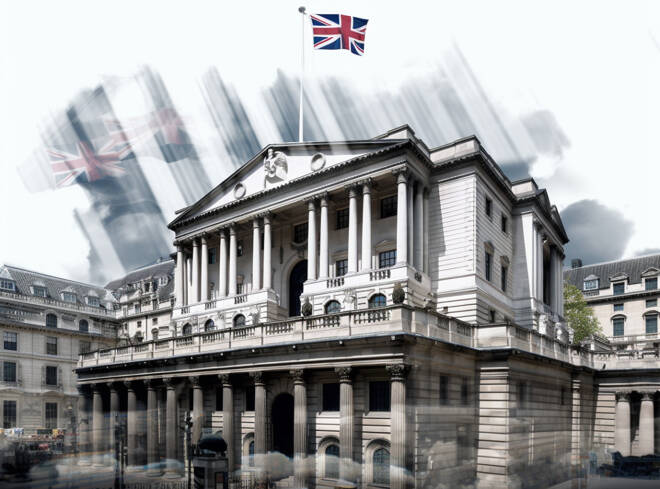Advertisement
Advertisement
BOE Trims Rates to 4.75%, Balances Easing with Inflation and Budget Uncertainty
By:
Key Points:
- BOE cuts rates by 25 bps to 4.75%, marking its second reduction this year as inflation eases, hinting at cautious future cuts.
- Inflation is cooling, but BOE projects a rise to 2.75% in 2025, above the 2% target, potentially limiting aggressive rate cuts.
- New £40 billion tax-hiking budget could curb BOE's ability to cut rates, aiming to stabilize growth but risks higher inflation.
- Gilt yields drop as BOE trims rates; 10-year and 2-year bond yields decrease by 2 and 4 bps, signaling market confidence.
- British pound gains 0.3% following BOE rate cut, as markets respond to a gradual but steady approach to easing.
Bank of England Cuts Rates, Signals Cautious Path Forward
The Bank of England (BOE) trimmed interest rates by 25 basis points on Thursday, setting the new benchmark rate at 4.75%. This marks the central bank’s second rate reduction since it initiated easing in August. With inflation easing, BOE policymakers have hinted at potential further cuts, though recent fiscal policies may slow the pace of future rate adjustments.
Inflation Cooling but Expected to Rise in 2025
The Monetary Policy Committee (MPC) voted 8-1 in favor of the rate cut, with members largely agreeing that inflation has moderated enough to warrant this move. Despite the easing trend, the BOE has revised its longer-term inflation forecast, predicting a slight uptick to around 2.75% in 2025. This projection suggests inflation will exceed the bank’s target of 2% before stabilizing, potentially influencing future rate decisions.
Government Budget Clouds Easing Outlook
The timing of additional rate cuts could be impacted by Labour’s recent budget, which includes substantial tax increases and modifications to U.K. debt rules. Announced by Finance Minister Rachel Reeves, the budget aims to raise £40 billion ($51.41 billion) and foster economic stability, yet could also increase growth and inflation in the near term. The Office for Budget Responsibility (OBR) has flagged this budget as a factor that might limit the BOE’s flexibility to cut rates as aggressively as markets had anticipated.
Goldman Sachs analysts echoed this sentiment, noting that “prospects for stronger 2025 growth are likely to reduce the urgency for sequential cuts in the near term.” The BOE’s “gradual approach” was evident in the September MPC meeting, when the committee opted to hold rates steady despite falling inflation and wage growth.
Market Reaction: Gilt Yields Drop, Sterling Rises
Following the rate cut, U.K. bond yields declined, with yields on 10-year and 2-year gilts losing approximately 2 and 4 basis points, respectively, by midday Thursday in London. Bond yields generally move inversely to prices and in line with interest rate adjustments, signaling confidence among investors in the BOE’s tempered approach to easing.
In currency markets, the British pound also responded positively to the BOE’s decision, rising 0.3% to reach $1.2929. The pound’s appreciation reflects market sentiment that while rates are gradually decreasing, the central bank remains cautious about easing too quickly.
Finance Minister’s Response and Economic Outlook
U.K. Finance Minister Rachel Reeves expressed approval of the BOE’s rate cut, acknowledging it as beneficial for households struggling with high costs. However, she emphasized that economic pressures on families remain significant. Reeves referred to prior government fiscal missteps, including former Prime Minister Liz Truss’s “mini-budget” in 2022, which led to significant market turmoil and required BOE intervention. Reeves positioned her recent budget as part of a strategy to deliver economic stability and long-term growth, though some analysts warn it may fuel inflationary pressures in the short term.
Market Forecast: Cautious Bullish Outlook
While the BOE’s rate cut reflects confidence in moderating inflation, the potential for higher inflation in 2025 and increased fiscal spending suggests a cautious approach ahead. Given the government’s expansive budget, the BOE may prioritize gradual adjustments, reducing the likelihood of rapid rate cuts. This measured stance, combined with supportive fiscal policy, indicates a cautiously bullish outlook for U.K. equities and gilts in the short term, although inflationary pressures will be closely monitored for shifts in the BOE’s approach.
About the Author
James Hyerczykauthor
James Hyerczyk is a U.S. based seasoned technical analyst and educator with over 40 years of experience in market analysis and trading, specializing in chart patterns and price movement. He is the author of two books on technical analysis and has a background in both futures and stock markets.
Advertisement
